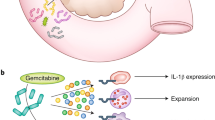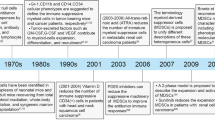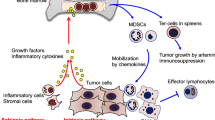Abstract
Pancreatic cancer is a devastating disease and ranks as the third most common cause of cancer-related death. Like many cancers, there has been increased interest in the role of the immune system in the progression and development of pancreatic cancer. In particular, immunosuppression within the tumor microenvironment (TME) is thought to impair the host’s antitumor response. In this article, we review myeloid-derived suppressor cells and their contribution to this immunosuppression within the pancreatic TME.
This is a preview of subscription content, access via your institution
Access options
Subscribe to this journal
Receive 12 print issues and online access
$259.00 per year
only $21.58 per issue
Buy this article
- Purchase on Springer Link
- Instant access to full article PDF
Prices may be subject to local taxes which are calculated during checkout


Similar content being viewed by others
References
Siegel RL, Miller KD, Jemal A . Cancer statistics, 2015. Cancer J Clin 2015; 65: 5–29.
Zhang Q, Zeng L, Chen Y, Lian G, Qian C, Chen S et al. Pancreatic cancer epidemiology, detection, and management. Gastroenterol Res Pract 2016; 2016: 8962321.
Lee HS, Park SW . Systemic chemotherapy in advanced pancreatic cancer. Gut Liver 2016; 10: 340–347.
Burris HA 3rd, Moore MJ, Andersen J, Green MR, Rothenberg ML, Modiano MR et al. Improvements in survival and clinical benefit with gemcitabine as first-line therapy for patients with advanced pancreas cancer: a randomized trial. J Clin Oncol 1997; 15: 2403–2413.
Kleeff J, Korc M, Apte M, La Vecchia C, Johnson CD, Biankin AV et al. Pancreatic cancer. Nat Rev Dis Primers 2016; 2: 16022.
Hanahan D, Weinberg RA . Hallmarks of cancer: the next generation. Cell 2011; 144: 646–674.
Nielsen MF, Mortensen MB, Detlefsen S . Key players in pancreatic cancer-stroma interaction: cancer-associated fibroblasts, endothelial and inflammatory cells. World J Gastroenterol 2016; 22: 2678–2700.
Binenbaum Y, Na'ara S, Gil Z . Gemcitabine resistance in pancreatic ductal adenocarcinoma. Drug Resist Updates: Rev Comment Antimicrob Anticancer Chemother 2015; 23: 55–68.
Waghray M, Yalamanchili M, Dziubinski M, Zeinali M, Erkkinen M, Yang H et al. GM-CSF mediates mesenchymal-epithelial crosstalk in pancreatic cancer. Cancer Discov 2016; 6: 886–899.
Horioka K, Ohuchida K, Sada M, Zheng B, Moriyama T, Fujita H et al. Suppression of CD51 in pancreatic stellate cells inhibits tumor growth by reducing stroma and altering tumor-stromal interaction in pancreatic cancer. Int J Oncol 2016; 48: 1499–1508.
Talmadge JE, Gabrilovich DI . History of myeloid-derived suppressor cells. Nat Rev Cancer 2013; 13: 739–752.
Bergenfelz C, Larsson AM, von Stedingk K, Gruvberger-Saal S, Aaltonen K, Jansson S et al. Systemic monocytic-MDSCs are generated from monocytes and correlate with disease progression in breast cancer patients. PLoS One 2015; 10: e0127028.
Zhang B, Wang Z, Wu L, Zhang M, Li W, Ding J et al. Circulating and tumor-infiltrating myeloid-derived suppressor cells in patients with colorectal carcinoma. PLoS One 2013; 8: e57114.
Stanojevic I, Miller K, Kandolf-Sekulovic L, Mijuskovic Z, Zolotarevski L, Jovic M et al. A subpopulation that may correspond to granulocytic myeloid-derived suppressor cells reflects the clinical stage and progression of cutaneous melanoma. Int Immunol 2016; 28: 87–97.
Youn JI, Gabrilovich DI . The biology of myeloid-derived suppressor cells: the blessing and the curse of morphological and functional heterogeneity. Eur J Immunol 2010; 40: 2969–2975.
Bronte V, Brandau S, Chen SH, Colombo MP, Frey AB, Greten TF et al. Recommendations for myeloid-derived suppressor cell nomenclature and characterization standards. Nat Commun 2016; 7: 12150.
Zhao Y, Wu T, Shao S, Shi B, Zhao Y . Phenotype, development, and biological function of myeloid-derived suppressor cells. Oncoimmunology 2016; 5: e1004983.
Movahedi K, Guilliams M, Van den Bossche J, Van den Bergh R, Gysemans C, Beschin A et al. Identification of discrete tumor-induced myeloid-derived suppressor cell subpopulations with distinct T cell-suppressive activity. Blood 2008; 111: 4233–4244.
Youn JI, Nagaraj S, Collazo M, Gabrilovich DI . Subsets of myeloid-derived suppressor cells in tumor-bearing mice. J Immunol 2008; 181: 5791–5802.
Kumar V, Patel S, Tcyganov E, Gabrilovich DI . The nature of myeloid-derived suppressor cells in the tumor microenvironment. Trends Immunol 2016; 37: 208–220.
Torroella-Kouri M, Rodriguez D, Caso R . Alterations in macrophages and monocytes from tumor-bearing mice: evidence of local and systemic immune impairment. Immunol Res 2013; 57: 86–98.
Helm O, Mennrich R, Petrick D, Goebel L, Freitag-Wolf S, Roder C et al. Comparative characterization of stroma cells and ductal epithelium in chronic pancreatitis and pancreatic ductal adenocarcinoma. PLoS One 2014; 9: e94357.
Lawrence T, Natoli G . Transcriptional regulation of macrophage polarization: enabling diversity with identity. Nat Rev Immunol 2011; 11: 750–761.
Kurahara H, Shinchi H, Mataki Y, Maemura K, Noma H, Kubo F et al. Significance of M2-polarized tumor-associated macrophage in pancreatic cancer. J Surg Res 2011; 167: e211–e219.
Ugel S, De Sanctis F, Mandruzzato S, Bronte V . Tumor-induced myeloid deviation: when myeloid-derived suppressor cells meet tumor-associated macrophages. J Clin Invest 2015; 125: 3365–3376.
Corzo CA, Condamine T, Lu L, Cotter MJ, Youn JI, Cheng P et al. HIF-1alpha regulates function and differentiation of myeloid-derived suppressor cells in the tumor microenvironment. J Exp Med 2010; 207: 2439–2453.
Kumar V, Cheng P, Condamine T, Mony S, Languino LR, McCaffrey JC et al. CD45 phosphatase inhibits STAT3 transcription factor activity in myeloid cells and promotes tumor-associated macrophage differentiation. Immunity 2016; 44: 303–315.
Narita Y, Wakita D, Ohkur T, Chamoto K, Nishimura T . Potential differentiation of tumor bearing mouse CD11b+Gr-1+ immature myeloid cells into both suppressor macrophages and immunostimulatory dendritic cells. Biomed Res 2009; 30: 7–15.
Ben-Baruch A . Inflammation-associated immune suppression in cancer: the roles played by cytokines, chemokines and additional mediators. Seminars Cancer Biol 2006; 16: 38–52.
Mantovani A, Sica A . Macrophages, innate immunity and cancer: balance, tolerance, and diversity. Curr Opin Immunol 2010; 22: 231–237.
Kurte M, Lopez M, Aguirre A, Escobar A, Aguillon JC, Charo J et al. A synthetic peptide homologous to functional domain of human IL-10 down-regulates expression of MHC class I and transporter associated with antigen processing 1/2 in human melanoma cells. J Immunol 2004; 173: 1731–1737.
Porembka MR, Mitchem JB, Belt BA, Hsieh CS, Lee HM, Herndon J et al. Pancreatic adenocarcinoma induces bone marrow mobilization of myeloid-derived suppressor cells which promote primary tumor growth. Cancer Immunol Immunother 2012; 61: 1373–1385.
Gabrilovich DI, Velders MP, Sotomayor EM, Kast WM . Mechanism of immune dysfunction in cancer mediated by immature Gr-1+ myeloid cells. J Immunol 2001; 166: 5398–5406.
Diaz-Montero CM, Salem ML, Nishimura MI, Garrett-Mayer E, Cole DJ, Montero AJ . Increased circulating myeloid-derived suppressor cells correlate with clinical cancer stage, metastatic tumor burden, and doxorubicin-cyclophosphamide chemotherapy. Cancer Immunol Immunother 2009; 58: 49–59.
Goedegebuure P, Mitchem JB, Porembka MR, Tan MC, Belt BA, Wang-Gillam A et al. Myeloid-derived suppressor cells: general characteristics and relevance to clinical management of pancreatic cancer. Curr Cancer Drug Targets 2011; 11: 734–751.
Bayne LJ, Beatty GL, Jhala N, Clark CE, Rhim AD, Stanger BZ et al. Tumor-derived granulocyte-macrophage colony stimulating factor regulates myeloid inflammation and T cell immunity in pancreatic cancer. Cancer Cell 2012; 21: 822–835.
Pylayeva-Gupta Y, Lee KE, Hajdu CH, Miller G, Bar-Sagi D . Oncogenic Kras-induced GM-CSF production promotes the development of pancreatic neoplasia. Cancer Cell 2012; 21: 836–847.
Takeuchi S, Baghdadi M, Tsuchikawa T, Wada H, Nakamura T, Abe H et al. Chemotherapy-derived inflammatory responses accelerate the formation of immunosuppressive myeloid cells in the tissue microenvironment of human pancreatic cancer. Cancer Res 2015; 75: 2629–2640.
Ko JS, Rayman P, Ireland J, Swaidani S, Li G, Bunting KD et al. Direct and differential suppression of myeloid-derived suppressor cell subsets by sunitinib is compartmentally constrained. Cancer Res 2010; 70: 3526–3536.
Dolcetti L, Peranzoni E, Ugel S, Marigo I, Fernandez Gomez A, Mesa C et al. Hierarchy of immunosuppressive strength among myeloid-derived suppressor cell subsets is determined by GM-CSF. Eur J Immunol 2010; 40: 22–35.
Hamilton JA . Colony-stimulating factors in inflammation and autoimmunity. Nat Rev Immunol 2008; 8: 533–544.
Pilon-Thomas S, Nelson N, Vohra N, Jerald M, Pendleton L, Szekeres K et al. Murine pancreatic adenocarcinoma dampens SHIP-1 expression and alters MDSC homeostasis and function. PLoS One 2011; 6: e27729.
Tu S, Bhagat G, Cui G, Takaishi S, Kurt-Jones EA, Rickman B et al. Overexpression of interleukin-1beta induces gastric inflammation and cancer and mobilizes myeloid-derived suppressor cells in mice. Cancer Cell 2008; 14: 408–419.
Bunt SK, Yang L, Sinha P, Clements VK, Leips J, Ostrand-Rosenberg S . Reduced inflammation in the tumor microenvironment delays the accumulation of myeloid-derived suppressor cells and limits tumor progression. Cancer Res 2007; 67: 10019–10026.
Seifert L, Werba G, Tiwari S, Giao Ly NN, Alothman S, Alqunaibit D et al. The necrosome promotes pancreatic oncogenesis via CXCL1 and Mincle-induced immune suppression. Nature 2016; 532: 245–249.
Mace TA, Ameen Z, Collins A, Wojcik S, Mair M, Young GS et al. Pancreatic cancer-associated stellate cells promote differentiation of myeloid-derived suppressor cells in a STAT3-dependent manner. Cancer Res 2013; 73: 3007–3018.
Muhlberg L, Kuhnemuth B, Costello E, Shaw V, Sipos B, Huber M et al. miRNA dynamics in tumor-infiltrating myeloid cells modulating tumor progression in pancreatic cancer. Oncoimmunology 2016; 5: e1160181.
Babiak LM, Rybak MJ . Hematological effects associated with beta-lactam use. Drug Intell Clin Pharm 1986; 20: 833–836.
Kumar V, Gabrilovich DI . Hypoxia-inducible factors in regulation of immune responses in tumour microenvironment. Immunology 2014; 143: 512–519.
Longo V, Brunetti O, Gnoni A, Cascinu S, Gasparini G, Lorusso V et al. Angiogenesis in pancreatic ductal adenocarcinoma: a controversial issue. Oncotarget 2016 (e-pub ahead of print).
Lunardi S, Muschel RJ, Brunner TB . The stromal compartments in pancreatic cancer: are there any therapeutic targets? Cancer Lett 2014; 343: 147–155.
Liu G, Bi Y, Shen B, Yang H, Zhang Y, Wang X et al. SIRT1 limits the function and fate of myeloid-derived suppressor cells in tumors by orchestrating HIF-1alpha-dependent glycolysis. Cancer Res 2014; 74: 727–737.
Huang B, Lei Z, Zhao J, Gong W, Liu J, Chen Z et al. CCL2/CCR2 pathway mediates recruitment of myeloid suppressor cells to cancers. Cancer Lett 2007; 252: 86–92.
Yang X, Lin Y, Shi Y, Li B, Liu W, Yin W et al. FAP promotes immunosuppression by cancer-associated fibroblasts in the tumor microenvironment via STAT3-CCL2 signaling. Cancer Res 2016; 76: 4124–4135.
Chang AL, Miska J, Wainwright DA, Dey M, Rivetta CV, Yu D et al. CCL2 produced by the glioma microenvironment is essential for the recruitment of regulatory T cells and myeloid-derived suppressor cells. Cancer Res 2016; 76: 5671–5682.
Chun E, Lavoie S, Michaud M, Gallini CA, Kim J, Soucy G et al. CCL2 promotes colorectal carcinogenesis by enhancing polymorphonuclear myeloid-derived suppressor cell population and function. Cell Rep 2015; 12: 244–257.
Hong J, Tobin NP, Rundqvist H, Li T, Lavergne M, García-Ibáñez Y et al. Role of tumor pericytes in the recruitment of myeloid-derived suppressor cells. J Natl Cancer Inst 2015; 107: djv209.
Werba G, Seifert L, Miller G . Necroptotic cell death - an unexpected driver of pancreatic oncogenesis. Cell Cycle 2016; 15: 2095–2096.
Strilic B, Yang L, Albarran-Juarez J, Wachsmuth L, Han K, Muller UC et al. Tumour-cell-induced endothelial cell necroptosis via death receptor 6 promotes metastasis. Nature 2016; 536: 215–218.
Gabrilovich DI, Nagaraj S . Myeloid-derived suppressor cells as regulators of the immune system. Nat Rev Immunol 2009; 9: 162–174.
Otsuji M, Kimura Y, Aoe T, Okamoto Y, Saito T . Oxidative stress by tumor-derived macrophages suppresses the expression of CD3 zeta chain of T-cell receptor complex and antigen-specific T-cell responses. Proc Natl Acad Sci USA 1996; 93: 13119–13124.
Nagaraj S, Gabrilovich DI . Regulation of suppressive function of myeloid-derived suppressor cells by CD4(+) T cells MDSC and CD4(+) T cells. Semin Cancer Biol 2012; 22: 282–288.
Qu P, Wang LZ, Lin PC . Expansion and functions of myeloid-derived suppressor cells in the tumor microenvironment. Cancer Lett 2016; 380: 253–256.
Vasquez-Dunddel D, Pan F, Zeng Q, Gorbounov M, Albesiano E, Fu J et al. STAT3 regulates arginase-I in myeloid-derived suppressor cells from cancer patients. J Clin Invest 2013; 123: 1580–1589.
Marvel D, Gabrilovich DI . Myeloid-derived suppressor cells in the tumor microenvironment: expect the unexpected. J Clin Invest 2015; 125: 3356–3364.
Haverkamp JM, Smith AM, Weinlich R, Dillon CP, Qualls JE, Neale G et al. Myeloid-derived suppressor activity is mediated by monocytic lineages maintained by continuous inhibition of extrinsic and intrinsic death pathways. Immunity 2014; 41: 947–959.
Lu B, Yang M, Wang Q . Interleukin-33 in tumorigenesis, tumor immune evasion, and cancer immunotherapy. J Mol Med 2016; 94: 535–543.
Pinton L, Solito S, Damuzzo V, Francescato S, Pozzuoli A, Berizzi A et al. Activated T cells sustain myeloid-derived suppressor cell-mediated immune suppression. Oncotarget 2016; 7: 1168–1184.
Li Y, Li F, Jiang F, Lv X, Zhang R, Lu A et al. A mini-review for cancer immunotherapy: molecular understanding of PD-1/PD-L1 pathway & translational blockade of immune checkpoints. Int J Mol Sci 2016; 17: 1151.
Marigo I, Dolcetti L, Serafini P, Zanovello P, Bronte V . Tumor-induced tolerance and immune suppression by myeloid derived suppressor cells. Immunol Rev 2008; 222: 162–179.
Yamamoto T, Yanagimoto H, Satoi S, Toyokawa H, Hirooka S, Yamaki S et al. Circulating CD4+CD25+ regulatory T cells in patients with pancreatic cancer. Pancreas 2012; 41: 409–415.
Lunardi S, Lim SY, Muschel RJ, Brunner TB . IP-10/CXCL10 attracts regulatory T cells: Implication for pancreatic cancer. Oncoimmunology 2015; 4: e1027473.
Huang B, Pan P-Y, Li Q, Sato AI, Levy DE, Bromberg J et al. Gr-1+CD115+ immature myeloid suppressor cells mediate the development of tumor-induced T regulatory cells and T-cell anergy in tumor-bearing host. Cancer Res 2006; 66: 1123–1131.
Viehl CT, Moore TT, Liyanage UK, Frey DM, Ehlers JP, Eberlein TJ et al. Depletion of CD4+CD25+ regulatory T cells promotes a tumor-specific immune response in pancreas cancer-bearing mice. Ann Surg Oncol 2006; 13: 1252–1258.
Suzuki E, Kapoor V, Jassar AS, Kaiser LR, Albelda SM . Gemcitabine selectively eliminates splenic Gr-1+/CD11b+ myeloid suppressor cells in tumor-bearing animals and enhances antitumor immune activity. Clin Cancer Res 2005; 11: 6713–6721.
Gurlevik E, Fleischmann-Mundt B, Brooks J, Demir IE, Steiger K, Ribback S et al. Administration of gemcitabine after pancreatic tumor resection in mice induces an antitumor immune response mediated by natural killer cells. Gastroenterology 2016; 151: 338–50.e7.
Meyer C, Sevko A, Ramacher M, Bazhin AV, Falk CS, Osen W et al. Chronic inflammation promotes myeloid-derived suppressor cell activation blocking antitumor immunity in transgenic mouse melanoma model. Proc Natl Acad Sci USA 2011; 108: 17111–17116.
Karakhanova S, Link J, Heinrich M, Shevchenko I, Yang Y, Hassenpflug M et al. Characterization of myeloid leukocytes and soluble mediators in pancreatic cancer: importance of myeloid-derived suppressor cells. Oncoimmunology 2015; 4: e998519.
Zhu Y, Knolhoff BL, Meyer MA, Nywening TM, West BL, Luo J et al. CSF1/CSF1R blockade reprograms tumor-infiltrating macrophages and improves response to T-cell checkpoint immunotherapy in pancreatic cancer models. Cancer Res 2014; 74: 5057–5069.
Lu P, Yu B, Xu J . Cucurbitacin B regulates immature myeloid cell differentiation and enhances antitumor immunity in patients with lung cancer. Cancer Biother Radiopharm 2012; 27: 495–503.
Huang HL, Chao MW, Chen CC, Cheng CC, Chen MC, Lin CF et al. LTP-1, a novel antimitotic agent and Stat3 inhibitor, inhibits human pancreatic carcinomas in vitro and in vivo. Sci Rep 2016; 6: 27794.
Author information
Authors and Affiliations
Corresponding author
Ethics declarations
Competing interests
The authors declare no conflict of interest.
Rights and permissions
About this article
Cite this article
Pergamo, M., Miller, G. Myeloid-derived suppressor cells and their role in pancreatic cancer. Cancer Gene Ther 24, 100–105 (2017). https://doi.org/10.1038/cgt.2016.65
Received:
Revised:
Accepted:
Published:
Issue Date:
DOI: https://doi.org/10.1038/cgt.2016.65
This article is cited by
-
Lipid metabolic features of T cells in the Tumor Microenvironment
Lipids in Health and Disease (2022)
-
ESE3-positive PSCs drive pancreatic cancer fibrosis, chemoresistance and poor prognosis via tumour–stromal IL-1β/NF–κB/ESE3 signalling axis
British Journal of Cancer (2022)
-
Conditioned media of pancreatic cancer cells and pancreatic stellate cells induce myeloid-derived suppressor cells differentiation and lymphocytes suppression
Scientific Reports (2022)
-
Vertebral body and splenic irradiation are associated with lymphopenia in localized pancreatic cancer treated with stereotactic body radiation therapy
Radiation Oncology (2021)
-
Immune checkpoint inhibition for pancreatic ductal adenocarcinoma: limitations and prospects: a systematic review
Cell Communication and Signaling (2021)



